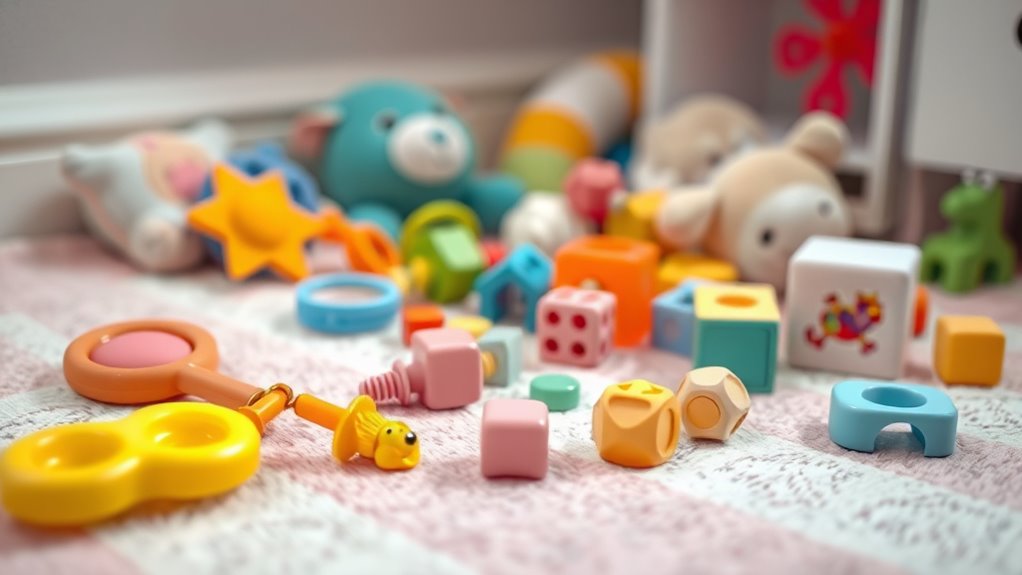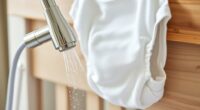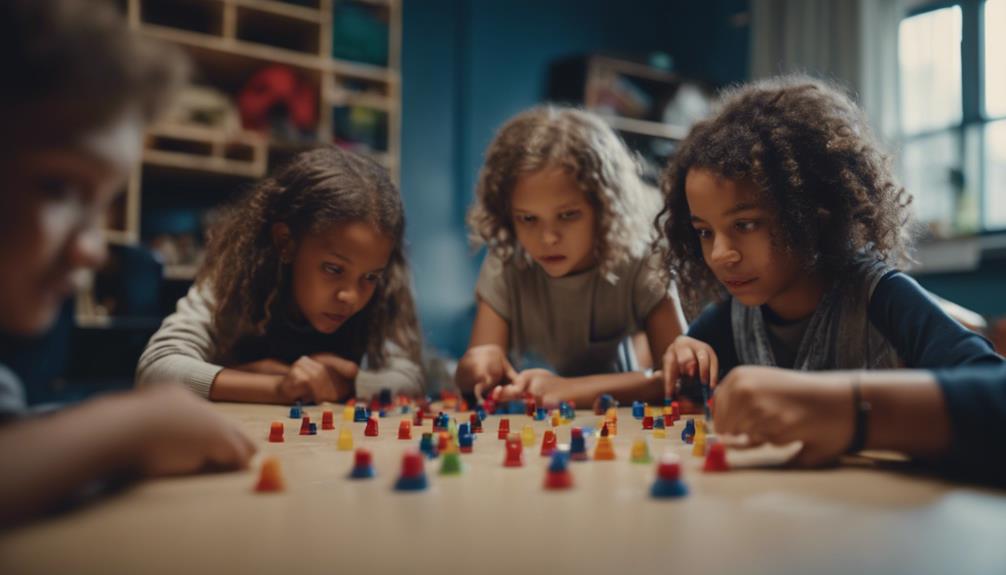Be cautious with popular toys for babies, as some may pose safety risks due to toxic materials, small parts, or loose components. Toys with sharp edges, removable beads, or fragile construction can cause choking, injuries, or poisoning. Always check labels for non-toxic paints and age recommendations. Keeping an eye on toy quality and wear helps prevent accidents. If you want to learn about these unsafe toys and how to avoid them, follow along for essential safety tips.
Key Takeaways
- Some popular toys may contain harmful chemicals like lead, phthalates, or BPA, posing health risks to babies.
- Small or detachable parts in trendy toys can be choking hazards for infants.
- Toys with sharp edges, loose components, or broken parts increase injury risks during play.
- Certain toys may be poorly constructed or made from unsafe materials, making them unsafe for babies.
- Lack of supervision or failure to inspect toys regularly can lead to accidents with popular, seemingly safe toys.

With the holiday season approaching, it’s more important than ever to stay vigilant about toy safety. Children, especially babies, are naturally curious, and their toys can quickly become hazards if you’re not careful. One of the most critical aspects to consider is the use of non toxic materials. Babies tend to put toys in their mouths, so ensuring that the toys are made from safe, non toxic materials is essential. Toxic substances in toys can lead to serious health issues, including poisoning or allergic reactions. Always check labels and opt for toys labeled as free from harmful chemicals like lead, phthalates, and BPA. Prioritize toys that are specifically designed for infants, as these are more likely to meet safety standards.
Prioritize non toxic, safe toys for infants to prevent health hazards and ensure safe play.
Choking hazards are another major concern when selecting toys for babies. Small parts, beads, or detachable pieces can easily be swallowed or inhaled, leading to choking episodes that could be life-threatening. Toys that are too small should be avoided altogether, and it’s crucial to regularly inspect toys for wear and tear. Over time, parts may become loose or break off, increasing the risk of choking. Choose toys with large, sturdy parts that can’t be swallowed or lodged in the throat. Pay close attention to age recommendations on packaging; manufacturers typically provide these to help guide your choices. Remember, even the most popular or trendy toys can be unsafe if they don’t meet safety standards or aren’t appropriate for your child’s age.
In addition to checking for non toxic materials and choking hazards, always examine the overall construction of the toy. Look for smooth edges, secure fastenings, and durable materials that won’t easily break apart. Avoid toys with sharp points or splinters, as these can cause cuts or injuries. Be wary of painted toys, and ensure that any paint used is non toxic and safely adhered. Do a quick test by pressing or bending parts to see if they hold up well under normal use; flimsy toys may break apart and create additional hazards. Recognizing the importance of vetting toys for safety can significantly reduce the risk of accidents.
Finally, always supervise your baby during playtime, especially with new or unfamiliar toys. Even with the safest toys, accidents can happen if children are left unsupervised. Regularly inspect your child’s toy collection and remove anything that shows signs of damage or wear. Staying vigilant about toy safety helps protect your little one from preventable injuries and ensures their playtime remains fun and safe.
Frequently Asked Questions
Are There Specific Brands Known for Safer Baby Toys?
When choosing safer baby toys, you wonder if certain brands stand out. You should look for brands with a strong reputation for safety and check for safety certifications like ASTM or CE marks. Reputable companies prioritize non-toxic materials and secure construction. By selecting brands known for these standards, you can better guarantee your baby’s safety. Always read reviews and labels to confirm that the toys meet safety guidelines before making a purchase.
How Often Should I Replace or Discard Old Toys?
You should regularly inspect your baby’s toys during toy maintenance, replacing or discarding them when they show signs of wear, damage, or loosened parts. Practicing toy rotation helps keep your baby engaged with fresh, safe toys while minimizing the risk of accidents. Aim to review toys every few months and dispose of any that are broken or unsafe to guarantee your child’s safety and enjoyment with age-appropriate items.
What Are the Safest Materials for Baby Toys?
When choosing the safest materials for baby toys, look for non-toxic plastics and BPA-free materials. These guarantee your baby isn’t exposed to harmful chemicals that could cause health issues. Always check labels and opt for toys made from safe, durable materials. You should also regularly inspect toys for damage and replace any that show signs of wear, ensuring your little one plays safely with toys that are free from harmful substances.
Can Certain Colors or Sounds Be Harmful to Babies?
Imagine your baby’s wide eyes, captivated by bright colors and gentle sounds. You should know that certain color effects can overstimulate, making your little one fussy or overwhelmed. Similarly, sound sensitivities vary; loud or sudden noises might scare or disturb them. Choose toys with soft, soothing sounds and calming colors to create a safe, comforting environment. Being mindful of these factors helps protect your baby’s delicate senses and promotes healthy development.
How Can I Identify Hidden Dangers in Toys Not Labeled?
You should always inspect toys carefully for hidden dangers, especially when labels are missing. Look for small parts, sharp edges, or loose components that could pose choking hazards. Check for signs of wear or damage that might reveal unlabeled risks. Trust your instincts and research the toy’s manufacturer if you’re unsure about safety. Keeping a close eye helps you spot hidden dangers and protect your baby from potential harm.
Conclusion
To keep your little one’s playtime joyful and worry-free, it’s best to stay a bit cautious about those tempting toys. By giving a quick glance for small parts or tricky materials, you’re gently guiding your baby toward safer adventures. Remember, a little extra check now can turn everyday play into a wonderful experience filled with giggles and discovery. After all, every parent’s love helps create a safer, happier world for your precious one.










